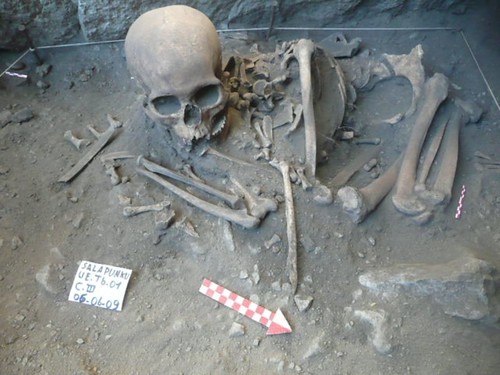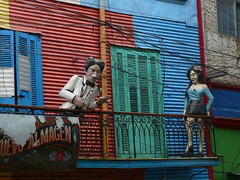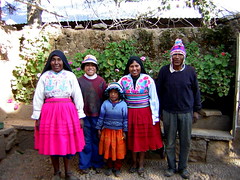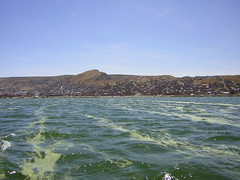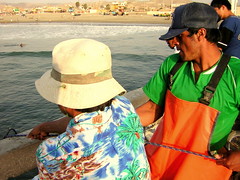Chullpas of Sillustani
At the shores of Lake Umayo, a small lake not 20km from Lake Titicaca, still stand the ancient funerary towers of Sillustani. Thought to be built by Aymara-speaking people called the Colla, they could show the origin of Inca architecture – a westward movement and evolution of Tiahuanaco technology. Whatever the case, the chullpas as they are known, stand out beautifully on the landscape of Puno’s bleak antiplano.
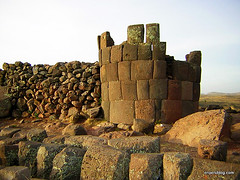
Ancient tomb
The Sillustani peninsula that extends out into Lake Umayo is a beautiful place and just 40km from the city of Puno – 20km from the much larger Lake Titicaca. In Sillustani, like most of the altiplano, the sun is blindingly bright but refuses to share any of its heat. At 4000 metres above sea level the air is chilly, the sky a perfect blue and the fluffy white clouds appear very close by. The ground is rocky in places, covered in moss in others. Grass can’t grow here. The rays of the sun reflect off the ripples in the large lake, in the middle of which is an odd looking island referred to as the table top for obvious reasons.
With just the sound of the wind and barely a person in sight, I can’t say it’s a bad location for eternal rest. The people who lived here buried their dead in towers they called chullpas. Cylindrical in shape, these would hold a mummy and various precious objects. Although this custom was also followed in a not too dissimilar way in other parts of the Andes there is no-where else where this burial technique was so prominent and with such skill effort employed to carry out. There were chambers inside the tombs, and these were built to resemble wombs. The dead were placed in the foetal position, with a single opening facing east toward the reborn rising sun.
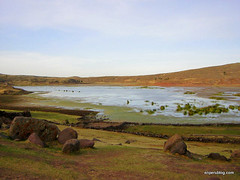
The altiplano
The chullpas come in various sizes and quality of build. Some are very roughly put together with field stones just piled on top of each other, while some are still field stones but cut minimally so that they slot together well. Others are constructed with adobe cement and so are well sealed, while some are constructed of bricks cut and fitted to perfection much like those of the Incas. Yet others are clearly of Inca origin. What are we to make of this?
The Aymara peoples of today’s Titicaca region, and what is now Bolivia, have a very proud heritage as descendants of one of the Andes’ greatest civilizations. Its great capital of Tiahuanaco demonstrated their capacity for building fine brick walls. These walls consisted of blocks cut very accurately so that they would fit together almost perfectly with no need for cement. The Wari, the civilisation that bordered them to the north-west in what is today called Peru, built roughly with small stones filling the gaps between large ones. While structurally brilliant and earthquake-proof, they were not as fine at those in Tiahuanaco or those of the Incas who came much much later. This is just one of the clues, along with Inca origin myths and linguistic evidence, that the Incas had their origin somewhere in the Titicaca region and are more culturally descended from this region’s great civilisations. Inca brick work, in that case, would be progression from brick work developed in this region.
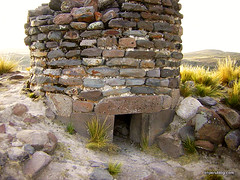
Entrance, or exit, of the tomb
So, the majority of Chullpas here are said to be the work of the post-Tiahuanaco Aymara warrior people called the Colla – cousins of the early Incas who set out west to settle in Cusco and to found a city state that hundreds of years later turned into an empire. Are the Colla responsible for the extraordinary fine chullpas? Or did they just make the low quality versions? Are all the fine ones from the Inca imperial period? Well, though the Incas, on conquering and ruling over the area, continued with the local tradition of chullpa burials and did indeed raise their own towers, some of the finest do in fact lack the Inca’s tell-tale 3D-like brick bevelling. They do appear to be a halfway between Tiahuanaco bricks and final Inca perfection.
Dating rock is impossible, and the tombs were long since raided, so it seems this part of Andean history can only be alluded to with some pretty intense theorising.
Tags: aymara, chullpas, lake titicaca, lake umayo, ruins, sillustani




